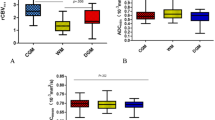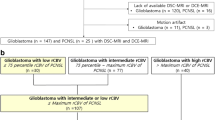Abstract
Tumefactive demyelinating lesions (TDLs) can mimic a neoplasm on conventional imaging and may necessitate biopsy for diagnosis. The purpose of this study was to differentiate TDLs from high grade gliomas based on physiologic (permeability) and hemodynamic (blood volume) parameters using perfusion CT. Five patients who presented with tumefactive enhancing lesions on initial MRI that mimicked a neoplasm underwent perfusion CT. We compared the perfusion CT parameters of these patients with those of 24 patients with high grade gliomas. TDLs showed lower permeability surface area product (PS) (0.8 ± 0.2 vs 2.4 ± 1.4 ml/100 g/min, P-value 0.014) and lower cerebral blood volume (CBV) (1.0 ± 0.2 vs 2.8 ± 1.2 ml/100 g, P-value 0.006) as compared to high grade gliomas. TDLs show lower PS and CBV as compared to high grade gliomas, to which they can mimic on conventional MR imaging, due to lack of neoangiogenesis and vascular endothelial proliferation and hence perfusion CT can be used to differentiate the two entities.


Similar content being viewed by others
References
Lucchinetti CF, Garvilova RH, Metz I et al (2008) Clinical and radiographic spectrum of pathologically confirmed tumefactive multiple sclerosis. Brain 131(7):1759–1775
Nesbit GM, Forbes GS, Scheithauer BW et al (1991) Multiple sclerosis: histopathologic and MR and/or CT correlation in 37 cases at biopsy and three cases at autopsy. Radiology 180:467–474
Dagher AP, Smirniotopoulos J (1996) Tumefactive demyelinating lesions. Neuroradiology 38(6):560–565
Sugita Y, Terasaki M, Shigemori M et al (2001) Acute focal demylinating disease simulating brain tumors: histopathologic guidelines for an accurate diagnosis. Neuropathology 21:25–31
Saindane AM, Cha S, Law M et al (2002) Proton MR spectroscopy of tumefactive demyelinating lesions. AJNR Am J Neuroradiol 23:1378–1386
Tan HM, Chan LL, Chuah KL et al (2004) Monophasic solitary tumefactive demyelinating lesion: neuroimaging features and neuropathological diagnosis. Br J Radiol 77:153–156
Zagzag D, Miller DC, Kleinman GM et al (1993) Demyelinating disease versus tumor in surgical neuropathology: clues to a correct pathological diagnosis. Am J Surg Pathol 17:537–545
Prineas JW, McDonald WI (1997) Demyelinating diseases Greenfield’s Neuropathology, vol I, 6th edn. Wiley, New York, pp 814–846
Hourani R, Brant LJ, Rizk T et al (2008) Can proton MR spectroscopic and perfusion imaging differentiate between neoplastic and non neoplastic brain lesions in adults? AJNR Am J Neuroradiol 29:366–372
Ge Y, Law M, Johnson G et al (2005) Dynamic susceptibility contrast perfusion MR imaging of multiple sclerosis lesions: characterizing hemodynamic impairment and inflammatory activity. AJNR Am J Neurorad 26:1539–1547
Jain R, Ellika SK, Scarpace LM et al (2008) Quantitative estimation of permeability surface-area product in astroglial brain tumors using perfusion CT and correlation with histopathological grade. AJNR Am J Neuroradiol 29:694–700
Annesley-Williams D, Farrell MA, Staunton H et al (2000) Acute demyelination neuropathological diagnosis, and clinical evolution. J Neuropathol Exp Neurol 59(6):477–489
Kepes JJ (1993) Large focal tumor-like demyelinating lesions of the brain: intermediate entity between multiple sclerosis and acute disseminated encephalomyelitis? A study of 31 patients. Ann Neurol 33:18–27
Shin JH, Lee HK, Kwun BD et al (2002) Using relative cerebral blood flow and volume to evaluate the histopathologic grade of cerebral gliomas: preliminary results. Am J Roentgenol 179:783–789
Roberts HC, Roberts TP, Brasch RC et al (2000) Quantitative measurement of microvascular permeability in human brain tumors achieved using dynamic contrast-enhanced MR imaging: correlation with histologic grade. AJNR Am J Neuroradiol 21:891–899
Roberts HC, Roberts TP, Bollen AW et al (2001) Correlation of microvascular permeability derived from dynamic contrast-enhanced MR imaging with histologic grade and tumor labeling index: a study in human brain tumors. Acad Radiol 8:384–391
Law M, Yang S, Babb JS et al (2004) Comparison of cerebral blood volume and vascular permeability from dynamic susceptibility contrast-enhanced perfusion MR imaging with glioma grade. AJNR Am J Neuroradiol 25(5):746–755
Jackson A, Kassner A, Annesley-Williams D et al (2002) Abnormalities in the recirculation phase of contrast agent bolus passage in cerebral gliomas: comparison with relative blood volume and tumor grade. AJNR Am J Neuroradiol 23:7–14
Ellika SK, Jain R, Patel SC et al (2007) Role of perfusion CT in glioma grading and comparison with conventional MR imaging features. AJNR Am J Neuroradiol 28:1981–1987
Ding B, Ling HW, Chen KM et al (2006) Comparison of cerebral blood volume and permeability in preoperative grading of intracranial glioma using CT perfusion imaging. Neuroradiology 48(10):773–781
Ge Y, Law M, Herbert J et al (2005) Prominent perivenular spaces in multiple sclerosis as a sign of perivascular inflammation in primary demyelination. AJNR Am J Neuroradiol 26:2316–2319
Cha S, Pierce S, Knopp EA et al (2001) Dynamic contrast enhanced T2* weighted MR imaging of tumefactive demyelinating lesions. AJNR Am J Neuroradiol 22:1109–1116
Provenzale JM, Wang GR, Brenner T et al (2002) Comparison of permeability in high-grade and low-grade brain tumors using dynamic susceptibility contrast MR imaging. AJR Am J Roentgenol 178:711–716
Author information
Authors and Affiliations
Corresponding author
Rights and permissions
About this article
Cite this article
Jain, R., Ellika, S., Lehman, N.L. et al. Can permeability measurements add to blood volume measurements in differentiating tumefactive demyelinating lesions from high grade gliomas using perfusion CT?. J Neurooncol 97, 383–388 (2010). https://doi.org/10.1007/s11060-009-0030-2
Received:
Accepted:
Published:
Issue Date:
DOI: https://doi.org/10.1007/s11060-009-0030-2




